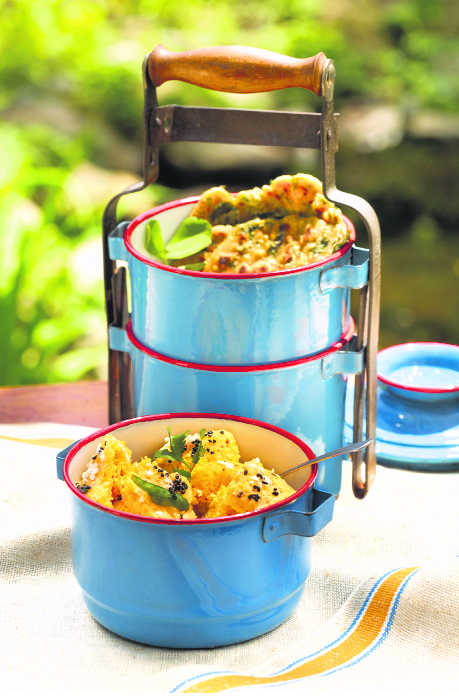Geetu Vaid
A conversation on food is one strategy that never fails if you want to break the ice in a room filled with strangers. Well, for that matter, even with friends and family, discussions on food preferences and favourite dishes and cooking styles can carry on well into the night, with everyone having something to contribute. Why? For one, because when it comes to food, each of us (even those who can’t differentiate tur daal from chana dal or coriander from mint) has a different story to tell. It is this line that author Rukmini Srinivas has taken to savour the memories of her childhood, youth and adulthood through a platter full of dishes and recipes in Tiffin.
It is said that taste is 80 per cent cerebral and 20 per cent of what you feel on your tongue. So the importance of mental associations that we form with different foods can’t be underestimated. Ever thought why you are always searching for that taste of sweet-and-tangy imli sold in front of your school or of the silken texture of the matka kulfi that the most-awaited vendor sold in hot-summer afternoons or the hot-stew that mom would rustle up on cold winter evenings, because the taste is a part of a memory of that time, of that you, and by looking for that taste one likes to revisit that time, that self, once more. This delicate thread of memories, life, persons and food forms the exquisite tapestry of this unique memoir cookbook.
Tiffin, which draws its origin from tiffing, refers to the small meals that have a history in Indian households, with each region home to a variety of dishes. The nutritious and filling small meals represent the eternal appeal of the traditional home-cooked Indian food. Rukmini, who hosts a TV cookery show and runs cookery classes in Boston area, has spent several decades whipping up delectable vegetarian recipes for people from other countries, serving as an ambassador of Indian cuisine.
She shared the rich heritage of this cuisine with her daughters settled in Boston area by spicing up the recipes with anecdotes from her life. It is these communications that are the genesis of the current volume. She presents recipes culled not from an old cookbook but from her book of life, as each memory is connected to a dish, an ingredient, a culture, a location. So be it Poona, Jubbulpore, Tanjore, Baroda or Berkeley, Rukka uses the gastronomical prism to give readers a glimpse of her life and world. It is also a chronicle of the times in which she grew up in a newly independent India. Thus the 100-odd recipes are seasoned with the aroma of memories and anecdotes to make them special.
Rukmini proves that vegetarian food is not all that bland and devoid of choices, rather the long list of recipes in the book unfold the whole range of vegetarian cuisines that have been around us in India in one form or the other.
Through the recipes, she presents the authentic taste of different regions of India, be it the Pidi Kozhukattai, Bombay Bonda, Gujarati farzan, pea samosa, vegetable korma or Rajasthani matri. What makes Rukka’s repertoire of recipes priceless is the inclusion of several complicated dishes that scare even the good cooks amongst us with the complexity of processes involved and the intricacy of flavours and spices required to achieve the perfect dish. She handholds one through these recipes like a mother, simplifying the complex processes and making it all look like a child’s play.
The narrative is simple and racy, coming straight from the heart and thereby touching the heart with its simplicity and honesty. The accounts of her father, her college life, famous author RK Narayan, and of finding anchor in a foreign country with her husband MN Srinivas, who was a renowned anthropologist, are heart touching.
It would be unfair not to talk about the visual aspect of the book. A cook book is like a lame dish if the visual element is weak or missing, but Tiffin scores a point on this front also. If Rukka brings the recipes from her past to life with her effective prose, Mohit Suneja brings the food and stories to life through his pictures and illustrations. This is what makes the book a collector’s item for those who love authentic Indian dishes and a good story.
Unlock Exclusive Insights with The Tribune Premium
Take your experience further with Premium access.
Thought-provoking Opinions, Expert Analysis, In-depth Insights and other Member Only Benefits
Already a Member? Sign In Now










